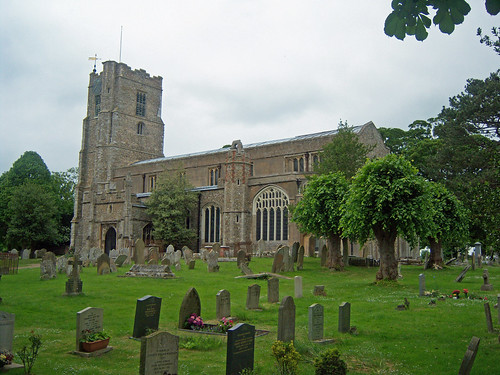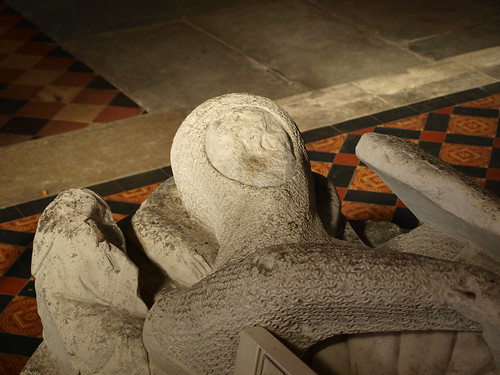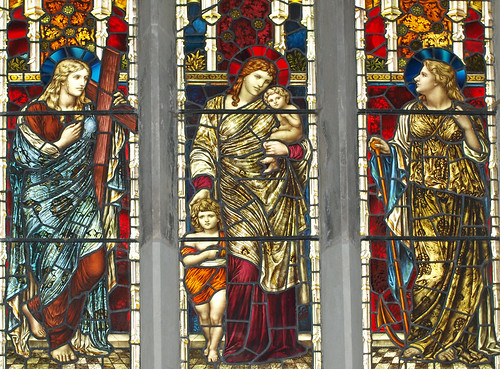ST MARY THE VIRGIN. The second Aubrey de Vere about 1135 founded here a Benedictine priory. The present church is the parts of the priory church W of the crossing. Of the parts further E nothing remains but the two W crossing piers, with demi-shafts and one waterleaf capital of c. 1175. The N wall of the present church also is C12, but the only ornamental feature surviving on the outside, two arches of a blank arcade, are a C15 enrichment. The fact that the aisle windows are placed so high is connected with the existence of the cloister on that side. In 1378, in a quarrel between the priory and the village, the cloister and part of the walls were damaged, and afterwards the nave and aisles must have been rebuilt. It is this state that we now see inside, arcades of five bays with piers of the common four-shaft-four-hollow section with no capitals above the hollows. Two-centred arches and extremely good small head-stops for the hood-moulds. The nave roof is of 1843, and very handsome with tiebeams and panelling to cover the rafters. Externally it is rather the C15 that dominates. To this belong most of the windows, the S porch which has a doorway with tracery spandrels, battlements, pinnacles, and three-light side openings with panel-tracery, the S turret to the former rood loft, the S chapel with a very large four-light window with panel tracery, and the big W tower with angle buttresses, steeped battlements, a higher stair turret, a W doorway with tracery spandrels, a three-light W window, and three-light transomed straightheaded bell-openings. The clerestory windows are, it seems, original late C14 work. The whole exterior of the church is of pebble-rubble, except for two later additions, the N Vestry of late C17 chequer brick and the Library to the E of the S chapel which was built in 1708. It contains 300 volumes of the C15 to C17. - REREDOS and CHANCEL PANELLING, early C18 and quite sumptuous. Ascribed to John Woodward, who, c. 1725, worked in Trinity College Chapel, Cambridge. - SEAT (W end of S aisle). Of the same date and the same courtly style, with openwork foliage scrolls. - COMMUNION RAIL with sturdy twisted balusters, the bulbous foot surrounded by growing-up leaves. Again belonging to the same set of woodwork. - SCULPTURE. The four Symbols of the Evangelists, probably from chancel stalls, also very good, and also early C18. - Kneeling figure of a worshiper, c. 30 ins. tall, of c. 1400. It was originally part of a hammer-beam truss in the chancel. - SCREEN. N chapel, C15, of simply traceried one-light divisions. - CANDELABRA. Gorgeous C18 piece, of brass, in the nave. - STAINED GLASS. One S window (Christ on the waves) by Hardman 1893. - MONUMENTS. Effigy said to be Robert de Vere, third Earl of Oxford, c. 1300, cross-legged, very defaced (chancel). - Sir John Barrington d. 1691. Standing wall-monument with two rather coarsely carved putti and an urn between them. - Sarah Chamberlayne d. 1742 and Richard Chamberlayne d. 1758, identical monuments with profiles in oval medallions in front of the usual obelisks. - Stanes Chamberlayne d. 1782, characteristically more classical in all the ornamental details; the portrait medallion here is at the foot, standing putti higher up. - Sir Charles Barrington d. 1788 by J. F. Moore of London, of marbles of various colours, with oval relief of mourning female figure, an urn and a weeping willow. - Lady Ibbetson d. 1816 by Flaxman, with two almost horizontally floating angels above the inscription plate.
HATFIELD BROAD OAK. It lies south of the thousand acres of Hatfield Forest, now in the keeping of the National Trust, where we see a lake and the famous Doodle Oak from which the village takes its name. Once a market town, it saw our Norman and Plantagenet kings come riding to the hunt, and has kept many of its 16th and 17th century houses with quaint gables and carved woodwork, nodding above the spacious street. It grew beside the priory founded by Aubrey de Vere about 1135, and prospered with it. But of the priory’s greatness little is left but part of the precinct wall, the old fish—ponds, and an impressive church once the nave of the priory church.
Its 15th century tower, 80 feet high, has taken the place of a central tower of which we can still see some of the piers, Norman workmanship like most of the north wall. A chapel by this Norman wall was rebuilt in two storeys in the 15th century, its windows high up to look over the cloister roof below. The nave arches, the chancel arch, and a turret on the south side are all 14th century; and about 100 years younger is the south porch with an embattled parapet, fine windows, and a sundial with two faces. The chancel roof is modern, but has four angels 500 years old; the aisle roofs are 14th century.
There is a 15th century screen, a Litany desk with an oak figure of a priest carved in Chaucer’s day, and a curious font cover with a patchwork of carving from three centuries. From the 18th century comes a very fine candelabra with 36 ornamental branches, and a medallion of Richard Chamberlayne. The nave has a little gallery of 14th century corbels, among them portraits of Richard the Second, Thomas Duke of Gloucester, Eleanor de Bohun, Edmund Langley, John of Gaunt, Robert Earl of Oxford, and Bishop Braybroke, who was a stout defender of the parson’s rights against the monks. Some of these helped to build this nave as a place of worship for the people. The chancel is enriched by a panelled reredos of the 18th century, said to have been carved by a pupil of Grinling Gibbons; and about as old are two chairs and the handsome altar rails.
To the south is a library built in the 18th century to shelter books given to the church in 1680. Among them are Matthew Prior’s poems, an Aldine Aristotle of 1498, a Vinegar Bible, and rare theological books. It is a curious room full of interest, and among its treasures is a brass showing the head of a 14th century woman,a relic from the priory and perhaps a portrait of Lady Margaret Beryngton. There is a parish doctor’s bill with other old documents, a 17th century chest with carving and poker-work, old stones from the priory, and a clarinet last played within living memory by an old man who died at 93.
Three monuments of three centuries are in the church. One shows cherubs and the arms of young Sir John Barrington, who died in 1691 ; another is to Lady Ibbetson of 1816, notable for being the work of Flaxman; and the third is a remarkable sculpture of Robert de Vere, the third Earl of Oxford. He is here in armour and a longcoat, his head on a pillow held by two worn hgures, his shield ornamented with diaper work, and at his feet two monks who seem to be reading at a desk. It is all the work of a sculptor more than 700 years ago, for the earl died in 1221. He was not only a friend of the priory his ancestor founded, but one of the 25 barons appointed to see that King John honoured the seal he had put to Magna Carta.
Flickr set.




No comments:
Post a Comment